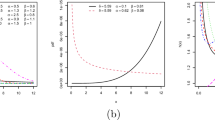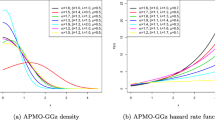Abstract
We introduce a flexible modified beta modified-Weibull model, which can accommodate both monotonic and non-monotonic hazard rates such as a useful long bathtub shaped hazard rate in the middle. Several distributions can be obtained as special cases of the new model. We demonstrate that the new density function is a linear combination of modified-Weibull densities. We obtain the ordinary and central moments, generating function, conditional moments and mean deviations, residual life functions, reliability measures and mean and variance (reversed) residual life. The method of maximum likelihood and a Bayesian procedure are used for estimating the model parameters. We compare the fits of the new distribution and other competitive models to two real data sets. We prove empirically that the new distribution gives the best fit among these distributions based on several goodness-of-fit statistics.







Similar content being viewed by others
References
Cintra RJ, Rêgo LC, Cordeiro GM, Nascimento ADC (2014) Beta generalized normal distribution with an application for SAR image processing. Stat A J Theor Appl Stat 48:279–294
Cordeiro GM, Edwin Ortega MM, Lemonte AJ (2014) The exponential-Weibull lifetime distribution. J Stat Comput Simul 84:2592–2606
Cordeiro GM, Gomes AE, Da-Silva CQ, Edwin Ortega MM (2013a) The beta exponentiated Weibull distribution. J Stat Comput Simul 83:114–138
Cordeiro GM, Silva GO, Edwin Ortega MM (2013) The beta-Weibull geometric distribution. Stat A J Theor Appl Stat 47:817–834
Cheng J, Tellambura C, Beaulieu NC (2003) Performance analysis of digital modulations on Weibull fading channels. In: 2003 IEEE 58th vehicular technology conference, VTC 2003-fall, vol 1. 2003 October 6–9, pp 236–240
Cowles MK, Carlin BP (1996) Markov chain Monte Carlo convergence diagnostics: a comparative review. J Am Stat Assoc 91:133–169
Erdélyi A, Magnus W, Oberhettinger F, Tricomi FG (1995) Higher transcendental functions, vol 1. McGraw–Hill, New York
Gelman A, Rubin DB (1992) Inference from iterative simulation using multiple sequences (with discussion). Stat Sci 7:457–472
Gradshteyn IS, Ryzhik IM (2007) Table of integrals, series, and products. Academic Press, New York
Gupta RC, Kirmani SNUA (2000) Residual coefficient of variation and some characterization results. J Stat Plan Inference 91:23–31
Jones MC (2004) Families of distributions arising from distributions of order statistics. Test 13:1–43
Khan MN (2015) The modified beta Weibull distribution. Hacet J Math Stat 44:1553–1568
Kang MS, Goo JH, Song I, Chun JA, Her YG, Hwang SW, Park SW (2013) Estimating design floods based on the critical storm duration for small watersheds. J Hydro-Environ Res 7:209–218
Kilbas AA, Srivastava HM, Trujillo JJ (2006) Theory and applications of fractional differential equations, vol 204. North-Holland mathematical studies. Elsevier (North-Holland) Science Publishers, Amsterdam
Lee C, Famoye F, Olumolade O (2007) Beta-Weibull distribution: some properties and applications to censored data. J Modern Appl Stat Methods 6:173–86
Lee ET, Wang JW (2003) Statistical methods for survival data analysis, 3rd edn. Wiley, New York
Luke YL (1969) The special functions and their approximations. Academic Press, San Diego
Mathai A, Saxena R (1978) The H-function with applications in statistics and other disciplines. Wiley Halsted, New York
Meijer CS (1946) On the \(G\)-function I–VIII. Proc Kon Ned Akad Wet, 49:227–237, 344–356, 457–469, 632–641, 765–772, 936–943, 1063–1072, 1165–1175
Nadarajah S, Kotz S (2006) The beta exponential distribution. Reliab Eng Syst Saftey 91:689–697
Nadarajah S, Teimouri M, Shih SH (2014) Modified beta distributions. Sankhya Ser B 76:19–48
Pham H, Lai CD (2007) On recent generalizations of the Weibull distribution. IEEE Trans Reliab 56:454–458
Prudnikov AP, Brychkov YA, Marichev OI (1986) Integrals and series, vol 1–4. Gordon and Breach Science Publishers, Amsterdam
Pundir S, Arora S, Jain K (2005) Bonferroni curve and the related statistical inference. Stat Probab Lett 75:140–150
Saboor A, Provost SB, Ahmad M (2012) The moment generating function of a bivariate gamma-type distribution. Appl Math Comput 218:11911–11921
Saboor A, Bakouch HS, Khan MN (2016) Beta Sarhan–Zaindin modified-Weibull distribution. Appl Math Model 40:6604–6621
Sarhan AM, Zaindin M (2009) Modified Weibull distribution. Appl Sci 11:123–136
Silva GO, Edwin Ortega MM, Cordeiro GM (2010) The beta modified Weibull distribution. Lifetime Data Anal 16:409–430
Singla N, Jain K, Sharma SK (2012) The beta generalized Weibull distribution: properties and applications. Reliab Eng Syst Safety 102:5–15
Acknowledgements
The research of Abdus Saboor has been supported in part by the Higher Education Commission of Pakistan (Grant No. 3104).
Author information
Authors and Affiliations
Corresponding author
Appendices
Appendix A. The unified Fox–Wright generalized hypergeometric function
Here,
stands for the unified variant of the Fox–Wright generalized hypergeometric function with p upper and q lower parameters; \((a,A)_p\) denotes the parameter p-tuple \((a_1, A_1), \ldots , (a_p, A_p)\) and \(a_j \in \mathbb C\), \(b_i \in \mathbb C\setminus \mathbb Z_0^-\), \(A_i, B_j>0\) for all \(j=\overline{1,p}, i=\overline{1,q}\). The power series converges for suitably bounded values of |z| when
In the case \(\varDelta = 0\), the convergence holds in the open disc \(|z|<\beta = \prod _{j=1}^qB_j^{B_j}\cdot \prod _{j=1}^pA_j^{-A_j}\).
The function \({}_1\varPsi _0^*\) is called confluent. The convergence condition \(\varDelta _{1,0} = 1-A_1>0\) is of special interest for us.
We point out that the original definition of the Fox–Wright function \({}_p\varPsi _q[z]\) (consult formula collection (Erdélyi et al. 1995) and the monographs (Kilbas et al. 2006; Mathai and Saxena 1978)) contains gamma functions instead of the generalized Pochhammer symbols used here. However, these two functions differ only up to constant multiplying factor, that is
The unification’s motivation is clear - for \(A_1 = \cdots = A_p = B_1 = \cdots = B_q = 1\), the fucntion \({}_p\varPsi _q^*[z]\) reduces exactly to the well-known generalized hypergeometric function \({}_pF_q[z]\).
Appendix B. Meijer G-function
The symbol \(G_{p,q}^{m,n}( \cdot |\, \cdot )\) denotes Meijer’s G-function (Meijer 1946) defined in terms of the Mellin–Barnes integral as
where \(0\le m\le q,\, 0\le n\le p\) and the poles \(a_j, b_j\) are such that no pole of \(\varGamma (b_j - s), j=\overline{1,m}\) coincides with any pole of \(\varGamma (1-a_j+s), j=\overline{1,n}\); i.e. \(a_k-b_j \not \in \mathbb N\), while \(z \ne 0\). \(\mathfrak C\) is a suitable integration contour, see [p.143] Luke (1969) and Meijer (1946) for more details.
The G function’s Mathematica code reads\( \texttt {MeijerG[}\{\{a_1,\ldots ,a_n\}, \{a_{n+1},\ldots ,a_p\}\}, \{\{b_1,\ldots ,b_m\}, \{b_{m+1},\ldots ,b_q\}\}, z\texttt {]}.\)
Rights and permissions
About this article
Cite this article
Saboor, A., Khan, M.N., Cordeiro, G.M. et al. Modified beta modified-Weibull distribution. Comput Stat 34, 173–199 (2019). https://doi.org/10.1007/s00180-018-0822-y
Received:
Accepted:
Published:
Issue Date:
DOI: https://doi.org/10.1007/s00180-018-0822-y




